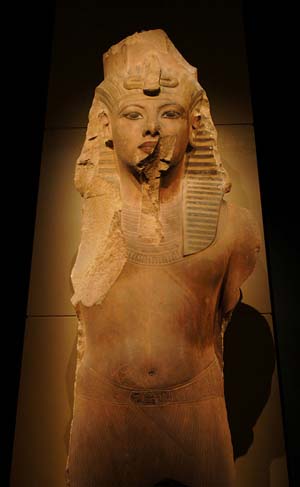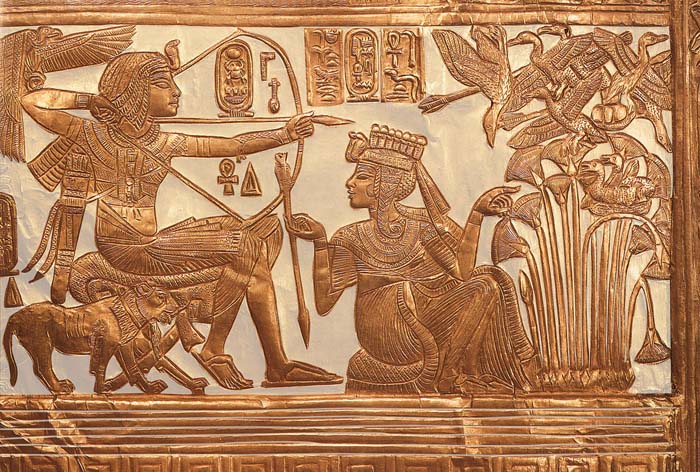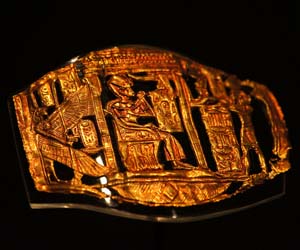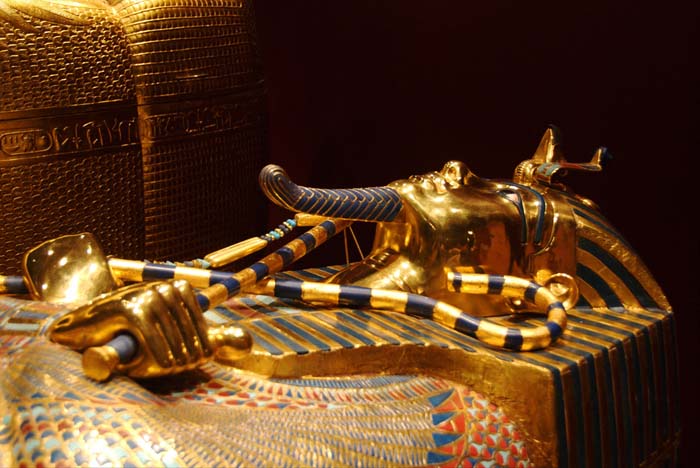King Tut Facts & FAQ
Although King Tut is one of the most well-known of the ancient Egyptian pharaohs today, he never played an important role in actual Egyptian history. Born around 1341 B.C., he was the 12th king of the 18th dynasty and came into power at the age of nine when his father, Akhenaten, died.
Tutankhamun ruled for nine years, but for the first few years of his reign, it’s likely that his vizier, Ay, had the real power. Ay and the highest ranking military commander at the time, Horemheb, likely joined forces to rule Egypt while young King Tut grew into a man.

© Tjflex2 - Tutankhamun Statue at Thebes
Born Tutankhaten, meaning “living image of Aten”, King Tut changed his name to Tutankhamun when his father died, and Ay and Horemheb changed ancient Egypt back into a polytheistic society.
Tutankhamun, also known as the “boy king”, is the son of one of the most controversial pharaohs in history, the “Heretic King”, Akhenaten. For the first time in the Egyptian history, the pharaoh worshiped just one god, instead of many. It isn’t known if Akhenaten was simply trying to elevate the status of Aten over all of the other gods, or if he truly believed that Aten, the sun god, was the only god.
Akhenaten’s beliefs caused enormous controversy within Egypt, and the capital city was moved from Thebes to Armana. Putting all of his efforts into his monotheistic views, King Tut’s father overlooked domestic and foreign affairs and after a reign of 17 years, he was likely forced to abdicate the throne. This, in turn, led to King Tut’s rise to power at such an early age.
At the age of 9, and in the same year he took the throne, King Tut married his half sister, Ankhesenamun. They had two daughters, but both were stillborn. Researchers have concluded that the children likely died of skeletal abnormalities, as many of King Tut’s relatives exhibited signs of skeletal abnormalities such as kyphoscoliosis, clubfoot, cleft palate and scoliosis, as well. King Tut himself suffered from a condition called Kohler Disease, which caused a deterioration of a bone in his foot, causing him to limp.

© Asaf Braverman - Depiction of Tutankhamun and Ankhesenamun
The circumstances surrounding King Tut’s death are still unknown today, but it is a widely held belief that he died from one of his many genetic physical impairments. His parents were brother and sister, and he likely inherited a condition due to this fact. Another possibility is that malaria, which caused the death of many ancient Egyptians, brought about his death, as well. It’s also possible the king could have died from a knee wound he sustained during battle. Evidence suggests that the severe knee wound could have caused the onset of gangrene, taking the young king’s life.
Tutankhamun is buried in the Valley of the Kings in a small tomb that had probably been built for a lesser-known noble. His untimely death meant that a proper king’s tomb had not yet been constructed. However, when King Tut’s tomb was discovered by British archaeologist, Howard Carter, in 1922, it was filled with treasures and was beautifully preserved.

© Tjflex2 - Plaque at Thebes, depicting King Tut
King Tut Facts
What’s in a Name? King Tut is known by Many
- At the time of his birth, King Tut was named Tutankhaten, the “aten” referring to the God, Aten, the Sun God, whom his father worshiped.
- When his father, Akhenaten, died, King Tut changes his name to Tutankhamun, the “Amun” referring to the God, Amun, the King of the Gods.
- In modern times, King Tut is known informally as “King Tut,” “The Boy King,” “The Child King,” and “The Golden King.”
King Tut’s Family
- King Tut’s father was the Amenhotep IV, also known as the Heretic King (because he worshiped just one god instead of many).
- King Tut’s mother was one of Amenhotep IV’s, sisters, likely Nefertiti or Kiya, Amenhotep IV’s second wife.
- King Tut married his half sister, who may have been his full-blooded sister (if his mother, was in fact, Nefertiti). Her name was Ankhesenamun. They were married when King Tut was nine years old.
- Children born from this union included two stillborn daughters. Research and analysis of the entombed children revealed that one was lost at 5 months gestation while the other was lost at 9 months gestation.
King Tut Timeline
- Born in Amarna 1343 B.C., King Tut reigned as pharaoh from 1334 B.C. to 1325 B.C.
- King Tut was the 12th King of the 18th Dynasty of ancient Egypt during the time of the New Kingdom.
- King Tut died at the age of 19 in 1323 B.C. The reason for his death remains a mystery.
How did the Boy King Die?
- One theory suggests that King Tut broke his leg (due to analysis indicating a fracture of his thighbone), and this could have led to gangrene and then death.
- He could have died during a chariot crash, which could have also been the cause of his thighbone fracture.
- King Tut could have died of malaria, due to multiple infections present inside his body.
- A fracture at the base of his skull could be indicative of his murder via a spear. Likely candidates for his murder include Ay and Horemhab who were ousted from power at the time when King Tut took over the throne.
King Tut’s Tomb
- King Tut was buried in tomb KV62, in the Valley of the Tombs
- British archaeologist, Howard Carter, discovered the tomb in 1922
- Thousands of priceless objects filled the tomb including rings, toys, oils, perfumes, funerary artifacts and more
- King Tut’s sarcophagus was made of solid gold, and was nested inside two others.
- Upon its discovery, King Tut’s tomb was intact and was the most impressive tomb ever found
Modern Day Revelations of the Boy King
- Howard Carter and his team examined King Tut’s mummy and revealed that he stood 5’6” tall.
- This examination also revealed that King Tut had scoliosis, a curvature of the spine.
- Bone fragments were found within his skull, as well as a contusion on his jaw.
- A 1968 x-ray revealed that the King’s breastbone was missing, as well as some of his ribs.
- An excessive amount of resin was used during the mummification process, but the reason remains unclear.
- Due to the King’s club feet, he wore orthopedic shoes. Three pairs were found in the tomb. The condition also likely forced him to walk with a cane.

© Kačka a Ondra - Inner coffin of Tutankhamun
FAQs
Who was Tutankhamun?
Tutankhamun was the 12th king of the 18th dynasty of ancient Egypt. He’s more well-known for his tomb than his reign as king in the 1300’s B.C.
How long did King Tut live?
Tutankhamun lived for approximately 19 years.
When did King Tut live?
He was born in 1341 B.C. and died in 1323 B.C.
By what names was King Tut known?
Born Tutankhaten, “Living Image of Aten,” King Tut later changed his name to reflect an overturning of his deceased father’s monotheistic policy to Tutankhamen. In modern times, he is known as King Tut, the “Boy King,” “Child King” and “The Golden King.”
Who were his parents?
King Tut’s father was the famous “Heretic King” (Amenhotep IV) who worshiped one god, Aten, instead of many. His mother was one of Amenhotep IV’s sisters, though it is unclear which one.
How old was Tutankhamun when he became a pharaoh?
King Tut became a pharaoh at the age of nine. His father was (likely) forced to relinquish his throne because of the controversy he stirred up with his monotheistic views. Soon after his father stepped down, he died. This leveraged the young Tutankhamun to the position of pharaoh at the age of nine.
Who was his wife?
King Tut’s wife was Ankhesenamun, half sister of the pharaoh, daughter of Akhenaten and Nefertiti. The couple was married the same year King Tut took over as pharaoh when he was nine years old.
Did King Tut have children?
King Tut and his wife, Ankhesenamun, had two daughters, but they were stillborn. Both of their coffins were found inside King Tut’s tomb, lying side by side and set inside a larger wooden box. It isn’t known why the children were stillborn, but analysis has indicated that one daughter died at five months pregnancy and the other at nine.
What was King Tut's religion?
Tutankhamun’s father, Akhenaten, sought to turn Egypt into a country that practiced monotheism, specifically worshiping the god Aten. This led to his downfall and when King Tut took the thrown, he changed his name from “Tutankhaten” which means “Living Image of Aten” to Tutankhamun, meaning “Living Image of Amun” which fell in line with the country’s previous beliefs. Tutankhamun and his regents turned Egypt back to the religious norms the country knew before his father’s reign.
During his reign he ordered that temples be rebuilt (after falling into disrepair during the time of his father’s reign) and he also refilled the temple treasuries that had been depleted when Akhenaten ruled. During the time of King Tut’s rule, the ancient Egyptians were once again able to worship any god they chose to.
When did he die?
King Tut died in 1323 B.C.
Who killed King Tut?
Since his burial chamber was discovered in 1922, there have been many theories surrounding the reasons behind King Tut’s death. While some of them do involve murder plots, recent discoveries invalidated these hypotheses.
How/why did Tutankhamun die?
Modern developments in science enabled researchers to study more closely the mummy of Tutankhamun and dismiss the former hypothesis of a chariot crash in favor of genetic issues caused by inbreeding (his parents were brother and sister). He likely never enjoyed good health and his foot was deformed, thus making it impossible for him to walk. This appears to be an explanation for the canes found in his tomb.
Although he did suffer from malaria, it is not confirmed yet whether this was a significant part in the cause of his death. Another trauma was the knee fracture believed to have occurred before embalming.
Theories of Tutankhamun's murder based on the fracture at the back of his head were dismissed. Recent examinations proved the area was damaged, along with several others, during the embalming process.
Where was he buried?
King Tut was buried in the Valley of the Tombs, specifically, tomb KV62.
How was King Tut found?
British archaeologist, Howard Carter, had been working in Egypt for 31 years before he discovered King Tut’s tomb. Working with Lord Carnarvon, Howard Carter cited the discovery of pieces evidence with King Tut’s name, which eventually led to the discovery of the tomb. This evidence included gold foil, a faience cup, and many funerary items. However, after five years of excavation, Carter still had little to show for it. Lord Carnarvon, Carter’s financier, agreed to one more season of excavating. Five days into the season, they discovered King Tut’s miraculously intact tomb.
How much treasure was in King Tut's Tomb?
King Tut’s tomb housed thousands of priceless objects. Some of these objects included funerary artifacts, rings, collars, bracelets, childhood toys, perfumes, oils, other precious jewelry and gold and ebony statues. Other items included a chariot, clothing and weapons. King Tut’s sarcophagus was made of solid gold sarcophagus and lay nested inside two others.
What did his mummy reveal after being examined?
The initial examination done by Carter and members of his expedition team revealed that King Tut stood 5’6” tall and had scoliosis (a curvature of the spine). They found bone fragments inside his skull and a contusion on his jaw. X-Rays performed in 1968 revealed that King Tut’s breastbone and some of his ribs were missing. An overabundance of resin was used in King Tut’s embalming process, but the exact reason for this remains unclear. DNA analysis also proved his lineage, including being the son of Akhenaten.
Click here to learn more about The Tomb of King Tut
